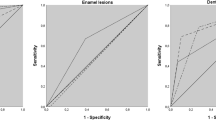Abstract
Objectives
The aims of this clinical study were to investigate the diagnostic accuracy of near-infrared light transillumination (NILT) as a novel X-ray-free method for proximal dentin caries detection and to compare this method to established diagnostic methods.
Materials and methods
A total of 127 interproximal dentin caries lesions without any cavity within visible dentin in posterior teeth from 85 consecutively selected patients were included. Visual and radiographic diagnoses and laser fluorescence measurements were available. NILT images were obtained, and a dentin lesion was predicted if a demineralisation involved the enamel-dentin junction (NILT-EDJ) or a shadow in dentin was detectable (NILT-dentin). Included lesions were opened and validated (reference standard). The statistical analyses included descriptive analyses and calculations of sensitivity, specificity and Az values.
Results
The diagnostic accuracy with respect to the reference standard was 1.6 % for visual inspection, 66.7 % for laser fluorescence, 96.1 % for digital radiography, 29.1 % for NILT-dentin and 99.2 % for NILT-EDJ. Bitewings (Az 0.984) and NILT-EDJ (Az 0.992) performed equally.
Conclusion
Given the lack of true negatives in the study, the diagnostic accuracy of NILT achieved the same level as bitewings for the detection of proximal dentin caries.
Clinical relevance
This study might indicate that NILT could reduce the usage of bitewings.



Similar content being viewed by others
References
Fried D, Glena RE, Featherstone JD, Seka W (1995) Nature of light scattering in dental enamel and dentin at visible and near-infrared wavelengths. Appl Opt 34:1278–1285
Young DA, Featherstone JD (2005) Digital imaging fiber-optic trans-illumination, F-speed radiographic film and depth of approximal lesions. J Am Dent Assoc 136:1682–1687
Young DA (2002) New caries detection technologies and modern caries management: merging the strategies. Gen Dent 50:320–331
Wenzel A, Verdonschot EH, Truin GJ, Konig KG (1992) Accuracy of visual inspection, fiber-optic transillumination, and various radiographic image modalities for the detection of occlusal caries in extracted non-cavitated teeth. J Dent Res 71:1934–1937
Schneiderman A, Elbaum M, Shultz T, Keem S, Greenebaum M, Driller J (1997) Assessment of dental caries with Digital Imaging Fiber-Optic TransIllumination (DIFOTI): in vitro study. Caries Res 31:103–110
Hall A, Girkin JM (2004) A review of potential new diagnostic modalities for caries lesions. J Dent Res 83 (Spec Issue No C):C89-C94
Jones R, Huynh G, Jones G, Fried D (2003) Near-infrared transillumination at 1310-nm for the imaging of early dental decay. Opt Express 11:2259–2265
Jones GC, Jones RS, Fried D (2004) Transillumination of interproximal caries lesions with 830-nm light. Proc SPIE 5313, Lasers in Dentistry X, 17 (May 28, 2004)
Staninec M, Lee C, Darling CL, Fried D (2010) In vivo near-IR imaging of approximal dental decay at 1,310 nm. Lasers Surg Med 42:292–298
Chung S, Fried D, Staninec M, Darling CL (2011) Near infrared imaging of teeth at wavelengths between 1200 and 1600 nm. Proc Soc Photo Opt Instrum Eng. 2011 Jan 1;7884. pii: 78840X
Bossuyt PM, Reitsma JB, Bruns DE, Gatsonis CA, Glasziou PP, Irwig LM, Lijmer JG, Moher D, Rennie D, de Vet HCW, for the STARD Group (2003). Towards complete and accurate reporting of studies of diagnostic accuracy: The STARD Initiative. BMJ 326:41–44
Pitts NB (2009) Detection, assessment, diagnosis and monitoring of caries. Monographs in Oral Science, Vol. 21. Basel: S. Karger AG
Kühnisch J, Goddon I, Berger S, Senkel H, Bücher K, Oehme T, Hickel R, Heinrich-Weltzien R (2009) Development, methodology and potential of the new Universal Visual Scoring System (UniViSS) for caries detection and diagnosis. Int J Environ Res Public Health 6:2500–2509
Kühnisch J, Bücher K, Henschel V, Albrecht A, Garcia-Godoy F, Mansmann U, Hickel R, Heinrich-Weltzien R (2011) Diagnostic performance of the universal visual scoring system (UniViSS) on occlusal surfaces. Clin Oral Investig 15:215–223
WHO (1997) Oral health surveys. Basic methods. 4th edition, World Health Organization, Geneva
Lussi A, Hellwig E (2006) Performance of a new laser fluorescence device for the detection of occlusal caries in vitro. J Dent 34:467–471
Huth KC, Lussi A, Gygax M, Thum M, Crispin A, Paschos E, Hickel R, Neuhaus KW (2010) In vivo performance of a laser fluorescence device for the approximal detection of caries in permanent molars. J Dent 38:1019–1026
Marthaler TM (1966) A standardized system of recording dental conditions. Helv Odontol Acta 10:1–18
Matthews DE, Farewell VT (2007) Using and understanding medical statistics, 4th edn. S. Karger GmbH, Freiburg
Baelum V (2010) What is an appropriate caries diagnosis. Acta Odontol Scand 68:65–79
Kühnisch J, Ifland S, Tranæus S, Heinrich-Weltzien R (2009) Comparison of visual inspection and different radiographic methods for dentine caries detection on occlusal surfaces. Dentomaxillofac Radiol 38:452–457
Pewsner D, Battaglia M, Minder C, Marx A, Bucher HC, Egger M (2004) Ruling a diagnosis in or out with “SpPIn” and “SnNOut”: a note of caution. BMJ 329:209–213
Hegedus EJ, Stern B (2009) Beyond SpPIN and SnNOUT: considerations with dichotomous tests during assessment of diagnostic accuracy. J Man Manip Ther 17:E1–E5
Rutjes AW1, Reitsma JB, Coomarasamy A, Khan KS, Bossuyt PM. Evaluation of diagnostic tests when there is no gold standard. A review of methods. Health Technol Assess. 2007 11(50):iii, ix-51
Lussi A, Hibst R, Paulus R (2004) DIAGNOdent: an optical method for caries detection. J Dent Res 83(Spec Iss C) C80-83
Bader JD, Shugars DA (2004) A systematic review of the performance of a laser fluorescence device for detecting caries. J Am Dent Assoc 135:1413–1426
Oxford centre for evidence-based medicine (2009). Levels of evidence. URL: www.cebm.net/index.aspx?o=4590 (accessed June 3th 2013)
Conflict of interest
The clinical work was supported by KaVo (Biberach, Germany). The authors declare that they have no conflicts of interest with regard to the authorship and/or publication of this article. Further, the publication of the study results was not hindered by any requests from the financial supporter.
Author information
Authors and Affiliations
Corresponding author
Rights and permissions
About this article
Cite this article
Kühnisch, J., Söchtig, F., Pitchika, V. et al. In vivo validation of near-infrared light transillumination for interproximal dentin caries detection. Clin Oral Invest 20, 821–829 (2016). https://doi.org/10.1007/s00784-015-1559-4
Received:
Accepted:
Published:
Issue Date:
DOI: https://doi.org/10.1007/s00784-015-1559-4




